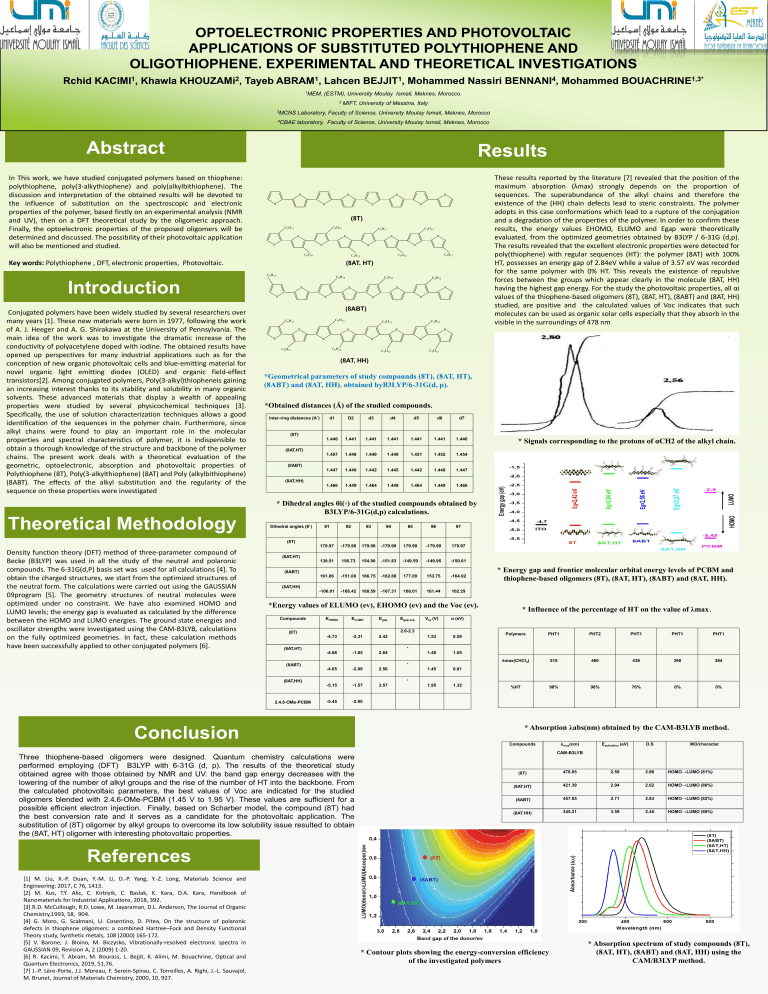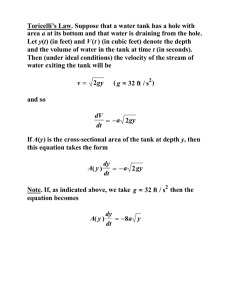
OPTOELECTRONIC PROPERTIES AND PHOTOVOLTAIC APPLICATIONS OF SUBSTITUTED POLYTHIOPHENE AND OLIGOTHIOPHENE. EXPERIMENTAL AND THEORETICAL INVESTIGATIONS Rchid KACIMI1, Khawla KHOUZAMi2, Tayeb ABRAM1, Lahcen BEJJIT1, Mohammed Nassiri BENNANI4, Mohammed BOUACHRINE1,3* 1MEM, (ESTM), University Moulay Ismail, Meknes, Morocco. 2 MIFT, University of Messina, Italy 3MCNS Laboratory, Faculty of Science, University Moulay Ismail, Meknes, Morocco 4CBAE laboratory, Faculty of Science, University Moulay Ismail, Meknes, Morocco Abstract In This work, we have studied conjugated polymers based on thiophene: polythiophene, poly(3-alkythiophene) and poly(alkylbithiophene). The discussion and interpretation of the obtained results will be devoted to the influence of substitution on the spectroscopic and electronic properties of the polymer, based firstly on an experimental analysis (NMR and UV), then on a DFT theoretical study by the oligomeric approach. Finally, the optoelectronic properties of the proposed oligomers will be determined and discussed. The possibility of their photovoltaic application will also be mentioned and studied. Results S S S S S (8T) C6H13 C6H13 S C6H13 C6H13 S S S S S S S C6H13 C6H13 C6H13 C6H13 Key words: Polythiophene , DFT, electronic properties, Photovoltaic. (8AT, HT) C6H13 Introduction Conjugated polymers have been widely studied by several researchers over many years [1]. These new materials were born in 1977, following the work of A. J. Heeger and A. G. Shirakawa at the University of Pennsylvania. The main idea of the work was to investigate the dramatic increase of the conductivity of polyacetylene doped with iodine. The obtained results have opened up perspectives for many industrial applications such as for the conception of new organic photovoltaic cells and blue-emitting material for novel organic light emitting diodes (OLED) and organic field-effect transistors[2]. Among conjugated polymers, Poly(3-alkyl)thiopheneis gaining an increasing interest thanks to its stability and solubility in many organic solvents. These advanced materials that display a wealth of appealing properties were studied by several physicochemical techniques [3]. Specifically, the use of solution characterization techniques allows a good identification of the sequences in the polymer chain. Furthermore, since alkyl chains were found to play an important role in the molecular properties and spectral characteristics of polymer, it is indispensible to obtain a thorough knowledge of the structure and backbone of the polymer chains. The present work deals with a theoretical evaluation of the geometric, optoelectronic, absorption and photovoltaic properties of Polythiophene (8T), Poly(3-alkylthiophene) (8AT) and Poly (alkylbithiophene) (8ABT). The effects of the alkyl substitution and the regularity of the sequence on these properties were investigated S S S These results reported by the literature [7] revealed that the position of the maximum absorption (λmax) strongly depends on the proportion of sequences. The superabundance of the alkyl chains and therefore the existence of the (HH) chain defects lead to steric constraints. The polymer adopts in this case conformations which lead to a rupture of the conjugation and a degradation of the properties of the polymer. In order to confirm these results, the energy values EHOMO, ELUMO and Egap were theoretically evaluated, from the optimized geometries obtained by B3LYP / 6-31G (d,p). The results revealed that the excellent electronic properties were detected for poly(thiophene) with regular sequences (HT): the polymer (8AT) with 100% HT, possesses an energy gap of 2.84eV while a value of 3.57 eV was recorded for the same polymer with 0% HT. This reveals the existence of repulsive forces between the groups which appear clearly in the molecule (8AT, HH) having the highest gap energy. For the study the photovoltaic properties, all αi values of the thiophene-based oligomers (8T), (8AT, HT), (8ABT) and (8AT, HH) studied, are positive and the calculated values of Voc indicates that such molecules can be used as organic solar cells especially that they absorb in the visible in the surroundings of 478 nm C6H13 S C6H13 C6H13 S S S S S S S (8ABT) C6H13 C6H13 S S S C6H13 C6H13 S S S S S C6H13 C6H13 C6H13 C6H13 (8AT, HH) *Geometrical parameters of study compounds (8T), (8AT, HT), (8ABT) and (8AT, HH). obtained byB3LYP/6-31G(d, p). *Obtained distances (Å) of the studied compounds. Inter-ring distances (A˚) d1 D2 d3 d4 d5 d6 d7 1.446 1.441 1.441 1.441 1.441 1.441 1.446 1.457 1.449 1.449 1.449 1.451 1.452 1.454 1.447 1.449 1.442 1.445 1.442 1.448 1.447 1.466 1.449 1.464 1.449 1.464 1.449 1.466 (8T) * Signals corresponding to the protons of αCH2 of the alkyl chain. (8AT,HT) (8ABT) (8AT,HH) * Dihedral angles θi(◦) of the studied compounds obtained by B3LYP/6-31G(d,p) calculations. Theoretical Methodology Dihedral angles (θ˚) θ1 θ2 θ3 θ4 θ5 θ6 θ7 179.97 -179.98 179.98 -179.99 179.99 -179.99 179.97 139.51 156.73 154.90 -151.83 -149.59 -149.95 -150.61 (8T) Density function theory (DFT) method of three-parameter compound of Becke (B3LYP) was used in all the study of the neutral and polaronic compounds. The 6-31G(d,P) basis set was used for all calculations [4]. To obtain the charged structures, we start from the optimized structures of the neutral form. The calculations were carried out using the GAUSSIAN 09program [5]. The geometry structures of neutral molecules were optimized under no constraint. We have also examined HOMO and LUMO levels; the energy gap is evaluated as calculated by the difference between the HOMO and LUMO energies. The ground state energies and oscillator strengths were investigated using the CAM-B3LYB, calculations on the fully optimized geometries. In fact, these calculation methods have been successfully applied to other conjugated polymers [6]. (8AT,HT) (8ABT) 161.86 -151.08 166.75 -162.88 177.09 153.75 -164.02 -106.01 -168.42 168.59 -167.31 108.01 161.44 102.29 * Energy gap and frontier molecular orbital energy levels of PCBM and thiophene-based oligomers (8T), (8AT, HT), (8ABT) and (8AT, HH). (8AT,HH) *Energy values of ELUMO (ev), EHOMO (ev) and the Voc (ev). Compounds EHOMO ELUMO Egap Voc (V) α (eV) 1.53 0.59 1.48 1.05 2.0-2.3 (8T) -4.73 -2.31 2.42 Polymers PHT1 PHT2 PHT1 PHT1 PHT1 λmax(CHCl3) 515 460 438 390 384 %HT 98% 98% 70% 0% 0% - (8AT,HT) -4.68 -1.85 2.84 - (8ABT) -4.65 -2.09 2.56 1.45 0.81 1.95 1.32 - (8AT,HH) 2.4.6-OMe-PCBM Egap exp * Influence of the percentage of HT on the value of λmax. -5.15 -1.57 -5.45 -2.90 Conclusion 3.57 * Absorption λabs(nm) obtained by the CAM-B3LYB method. Compounds Three thiophene-based oligomers were designed. Quantum chemistry calculations were performed employing (DFT) B3LYP with 6-31G (d, p). The results of the theoretical study obtained agree with those obtained by NMR and UV. the band gap energy decreases with the lowering of the number of alkyl groups and the rise of the number of HT into the backbone. From the calculated photovoltaic parameters, the best values of Voc are indicated for the studied oligomers blended with 2.4.6-OMe-PCBM (1.45 V to 1.95 V). These values are sufficient for a possible efficient electron injection. Finally, based on Scharber model, the compound (8T) had the best conversion rate and it serves as a candidate for the photovoltaic application. The substitution of (8T) oligomer by alkyl groups to overcome its low solubility issue resulted to obtain the (8AT, HT) oligomer with interesting photovoltaic properties. λmax(nm) Eactivation (eV) O.S MO/character CAM-B3LYB (8T) 478.05 2.59 2.96 HOMO→LUMO (81%) (8AT.HT) 421.39 2.94 2.62 HOMO→LUMO (80%) (8ABT) 457.05 2.71 2.83 HOMO→LUMO (82%) (8AT.HH) 345.21 3.59 2.45 HOMO→LUMO (69%) References [1] M. Liu, X.-P. Duan, Y.-M. Li, D.-P. Yang, Y.-Z. Long, Materials Science and Engineering: 2017, C 76, 1413. [2] M. Kus, T.Y. Alic, C. Kirbiyik, C. Baslak, K. Kara, D.A. Kara, Handbook of Nanomaterials for Industrial Applications, 2018, 392. [3] R.D. McCullough, R.D. Lowe, M. Jayaraman, D.L. Anderson, The Journal of Organic Chemistry,1993, 58, 904. [4] G. Moro, G. Scalmani, U. Cosentino, D. Pitea, On the structure of polaronic defects in thiophene oligomers: a combined Hartree–Fock and Density Functional Theory study, Synthetic metals, 108 (2000) 165-172. [5] V. Barone, J. Bloino, M. Biczysko, Vibrationally-resolved electronic spectra in GAUSSIAN 09, Revision A, 2 (2009) 1-20. [6] R. Kacimi, T. Abram, M. Bourass, L. Bejjit, K. Alimi, M. Bouachrine, Optical and Quantum Electronics, 2019, 51,76. [7] J.-P. Lère-Porte, J.J. Moreau, F. Serein-Spirau, C. Torreilles, A. Righi, J.-L. Sauvajol, M. Brunet, Journal of Materials Chemistry, 2000, 10, 927. * Contour plots showing the energy-conversion efficiency of the investigated polymers * Absorption spectrum of study compounds (8T), (8AT, HT), (8ABT) and (8AT, HH) using the CAM/B3LYP method.

